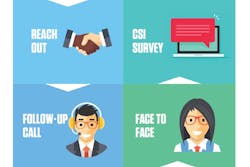Eddie Naser possesses many mottos.
Several of Naser’s professional philosophies revolve around the importance of thoroughly communicating with customers. The general manager at Twin City Hyundai in Alcoa, Tenn., feels it’s imperative to truly listen to customers, so you can fully diagnose their concerns.
“We have a saying here: There’s no problems in this world―there’s only solutions,” says Naser, in his 13th year as a GM in eastern Tennessee. “It’s like when you go into your physician and say, ‘Hey, this hurts.’ But he doesn’t know what ‘this’ is yet, so, he’s got to ask you a couple questions and make sure that he finds a solution. Same thing with us” at dealerships.
Naser’s employer boasts a nearly 63 percent customer retention rate and a service department CSI score approaching the mid 90s. He indicates stellar customer follow-up procedures have played a key role in that success. Here are some of Naser’s words of wisdom when it comes to customer follow-up procedures.
“Reach out to every customer, every single time.”
At Twin City Hyundai, Naser makes sure that customers receive frequent service reminders, and promptly receive communication regarding recalls. It’s all part of the dealership’s efforts to keep its face in front of customers, and drown out sales pitches from competitors.
“If you stop reaching out to your customers, you’ve lost them,” Naser says. “Because your competition is out there, and they’re reaching out to them … trying to extract your customers away from you.”
“Remember: Customers are the backbone of your business.”
It’s important to acknowledge that your business couldn’t survive without its clients, Naser notes. So, even if a customer angrily barges into your collision repair center, it’s important to patiently listen to their issues.
Consider this: According to a Harvard Business Review study, one upset customer will tell 14 people about a bad experience they have at a business. However, if the business successfully resolves that customer’s issue, the customer will tell five others how great the business is.
“One of the philosophies we have here is, when you’re talking to a customer,” Naser says, “you need to put yourself in their shoes.”
“We love CSI. We love the feedback.”
The staff at Twin City Hyundai values customer feedback―in the form of CSI surveys, for example―because that helps point out growing issues that need to be addressed. The dealership also utilizes a customer follow-up process in which the facility sends an email to customers within 30 days of their visit to Alcoa and, not long after, a mail piece. The dealership, which also uses text messaging to reach out to customers, also attempts to schedule maintenance appointments 90 days out.
All those follow-up measures help the dealership maintain contact with customers, Naser explains.
“You want to make sure that customers know you still care enough about them,” the GM says, “and that it wasn’t … ‘I fixed your car, so I’ll see you in 3,000 miles, or in three months.’”
“Five minutes, face to face, is very important.”
When it comes to parts sales, Naser feels one-on-one, face-to-face interaction remains invaluable, even in 2017. As such, Twin City Hyundai has members of its parts department deliver wholesale parts most mornings, and those employees are encouraged to go out and provide sales pitches, in person, to potential new customers each afternoon. After all, parts customers are often inundated with solicitations via email and phone.
“Technology has taken away having a normal conversation, and asking, ‘What can we do for you?” Naser says. “With that kind of clientele, that’s what they want.”
“The most important customers are the ones that DON’T tell you what’s wrong.”
As alluded to earlier, customer follow-up procedures can help your dealership pinpoint the elements of your business that are missing the mark. That’s why Twin City Hyundai has an employee search its customer database and call clients that have visited recently and ask how their experience was.
Naser says it helps to have a business development center employee reach out to customers and follow up, rather than, say, a member of the service department. The most important thing is to get clients to open up, he adds, because if they don’t reveal any concerns they might have with your business, it’ll likely result in a two-pronged problem: Your business will miss out on an opportunity to improve, and lose a customer in the process.
“Sometimes just the different voice, from a separate” department, Naser notes, gets “you a lot more feedback.”

